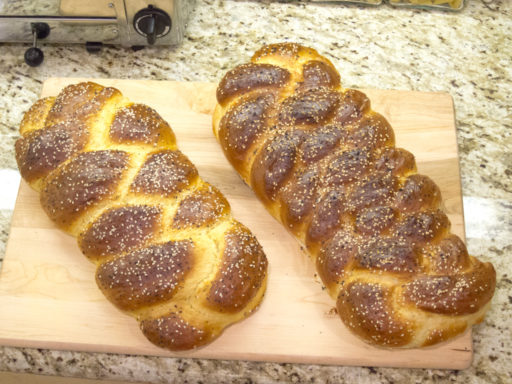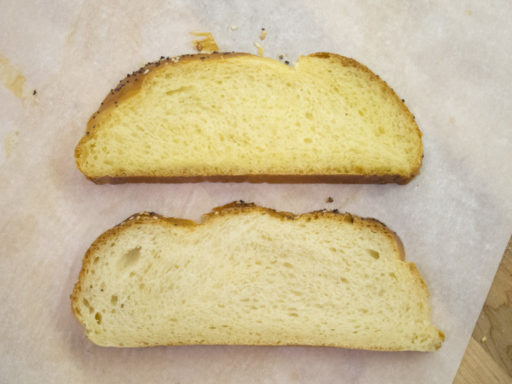Challah Recipe Bake-Off Results
Loaves 12 and 13 were both challah breads made from different recipes. Loaf 12 was from Peter Reinhart’s Artisan Breads Every Day book, and Loaf 13 was from Williams-Sonoma Collection: Bread. I’ve made the W-S challah quite a few times, and this was my first time making the Reinhart challah.
Recipe Differences
Reinhart’s recipe takes longer because the dough rises in the fridge overnight, but overall is about a three hour process. The W-S can be done in a day, but is about a five hour process. The actual amount of time spent with each recipe is only about an hour. Neither one is difficult, despite the beautiful results.
I was interested in doing both recipes side by side because of the different ratios of ingredients. Below is a table with the ingredients for comparison. The “Ratio” column is a normalized difference – in other words, if they both used the same amount of flour how would the amount of the other ingredients compare? (The Reinhart recipe makes two loaves, the W-S makes one slightly larger loaf.) The Reinhart recipe uses 30% more water and almost 3x the amount of eggs, along with much more yeast. Additionally, the Reinhart recipe only uses the egg yolks.
| Ingredient | Williams-Sonoma | Reinhart | Ratio |
| Flour (g) | 700 | 964 | 1.0x |
| Water (oz) | 10 | 18 | 1.3x |
| Yeast (tbsp) | 1 | 2 | 1.5x |
| Sugar (tbsp) | 4 | 6 | 1.1x |
| Eggs | 2 (whole) | 8 (yolks) | 2.9x |
| Oil (oz) | 2 | 2.5 | 0.9x |
| Salt (tsp) | 1.5 | 2.5 | 1.2x |
| Vanilla (tbsp) | 1 |
Results
Appearance
Other than a different braiding pattern (3 vs. 4 ropes) and different sizes, the loaves’ external appearance was very similar. The Reinhart loaves parted at the seams, but that may be a difference between three and four rope braids. The W-S loaf showed some “stretch marks” from rolling out the ropes that I haven’t noticed when I made that recipe before.
Internally, the colors were very different. Predictably, the use of more eggs and only yolks in the Reinhart recipe made a huge difference in giving the bread the distinctive yellow coloring of challah bread. In comparison it made the W-S recipe look absolutely white. The crumb quality was nearly identical between the two loaves.
Smell and Taste
I was surprised that the W-S loaf had a much stronger yeast smell, even though the Reinhart loaf had 50% more yeast. The Reinhart loaf initially smelled odd to me, but then I realized it smelled much more like an omelet than like bread – this was initially a bit off-putting, but once I recognized the source it didn’t bother me. Either the yeast in the Reinhart loaf mellowed by the long, slow rise, or it was masked by the eggs.
The flavors were unique, with the egg flavor coming through quite strongly in the Reinhart loaf. In comparison, the W-S loaf seemed bland. The Reinhart’s flavor was particularly nice the next morning toasted.
Taste comparison is definitely a significant thing to do, when I’ve make the W-S challah in the past it always seemed to have a very distinctive flavor, but that was overpowered here by the Reinhart soufflé.
Conclusion
This round goes to Reinhart for its distinctive color and flavor. But… I wouldn’t hesitate to make the Williams-Sonoma challah again if I needed it done in a day.








